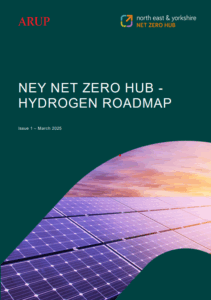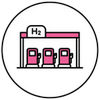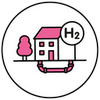This study was commissioned to understand the interdependency and opportunity of hydrogen demand and supply in the North East and Yorkshire, which generated a number of options for inland hydrogen production that could help inform the region’s local growth, collaboration, and infrastructure plans.
What is the Hydrogen Roadmap?

The Hydrogen Roadmap commissioned by the North East and Yorkshire (NEY) Net Zero Hub outlines a strategic vision for hydrogen deployment across the region, aiming to support the UK’s 2050 Net Zero targets. The study integrates local plans and policies into a regional model, identifying synergies, investment needs, and opportunities for collaboration. With significant hydrogen production potential in the Humber and Teesside clusters, and high industrial demand, the region is well-positioned to lead in hydrogen development.
A digital, geospatial model was developed to simulate hydrogen production, distribution, and demand under various scenarios. The model anticipates hydrogen demand reaching 41 TWh by 2040, with 8.5 GW of production capacity – mostly blue hydrogen – generating 54 TWh. Key sectors include industry, power, aviation, and shipping. The roadmap highlights the need for £14 billion in investment and the potential to support up to 40,000 construction jobs.
The report also explores risks, such as reliance on a few large-scale projects and uncertainties in sectoral uptake. It emphasises the importance of infrastructure like the East Coast Hydrogen (ECH) network and storage facilities. A regional action plan and working group are proposed to coordinate efforts and ensure the roadmap’s successful implementation.
What can local authorities learn from this report?
The Hydrogen Roadmap provides a valuable blueprint for local authorities aiming to support the UK’s Net Zero goals through hydrogen development. It offers:
- A replicable framework for regional hydrogen planning and modelling.
- Insights into aligning local strategies with national hydrogen and decarbonisation policies.
- Guidance on infrastructure needs, investment opportunities, and job creation potential.
- Awareness of risks and dependencies to inform resilient local planning.
- A model for cross-sector collaboration and stakeholder engagement.
By applying these insights, local authorities can better position themselves to attract funding, support innovation, and contribute meaningfully to the UK’s low-carbon transition.
A timeline of the roadmap’s predictions

Initial hydrogen production begins at small-scale plants, supplying local transport and early industrial users. With no major pipelines yet, distribution remains limited. Total production is expected to reach 1.1 TWh.

Large-scale hydrogen production launches in Humber and Tees. The first phase of the East Coast Hydrogen (ECH) pipeline goes live, enabling regional distribution and boosting demand to around 11 TWh.

ECH’s second phase is under construction. More production sites come online, supporting growing demand from power generation and shipping. Hydrogen capacity reaches 7.4 GW, nearing the UK’s 10 GW target.

ECH expands to Leeds and Doncaster, adding 650 km of pipeline. This unlocks wider industrial and shipping demand, embedding hydrogen more deeply into the region’s energy and transport systems.

ECH’s final phase connects more industrial and urban areas. Production scales to 54 TWh, with demand rising due to aviation fuel uptake and new connections across West Yorkshire and beyond.

